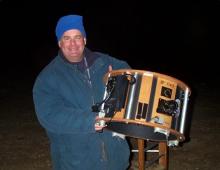Feed aggregator
New technique to detect dark matter using atomic clocks and lasers
A team of international researchers has developed an innovative approach to uncover the secrets of dark matter in the cosmos. They are searching for dark matter using atomic clocks and cavity-stabilized lasers.
Alien ocean could hide signs of life from spacecraft
A new study focusing on Enceladus, a moon of Saturn, shows that the physics of alien oceans could prevent evidence of deep-sea life from reaching places where we can detect it.
Largest radio jet ever seen in the early universe
Astronomers have characterized the largest-ever early-Universe radio jet. Historically, such large radio jets have remained elusive in the distant Universe. With these observations, astronomers have valuable new insights into when the first jets formed in the Universe and how they impacted the evolution of galaxies.
Meteorite discovery challenges long-held theories on Earth's missing elements
Earliest inner solar system planetesimals shaped the inventory of moderately volatile elements in terrestrial planets.
Wobbling stars reveal hidden companions in Gaia data
Using data from the European Space Agency's Gaia mission, scientists have found a huge exoplanet and a brown dwarf. This is the first time a planet has been uniquely discovered by Gaia's ability to sense the gravitational tug or 'wobble' the planet induces on a star. Both the planet and brown dwarf are orbiting low-mass stars, a scenario thought to be extremely rare.
Straight shot: Hubble investigates galaxy with nine rings
NASA's Hubble Space Telescope has captured a cosmic bullseye! The gargantuan galaxy LEDA 1313424 is rippling with nine star-filled rings after an 'arrow' -- a far smaller blue dwarf galaxy -- shot through its heart. Astronomers using Hubble identified eight visible rings, more than previously detected by any telescope in any galaxy, and confirmed a ninth using data from the W. M. Keck Observatory in Hawaii. Previous observations of other galaxies show a maximum of two or three rings.
A less 'clumpy,' more complex universe?
New research has combined cosmological data from two major surveys of the universe's evolutionary history and found hints that it may be less clumpy at certain points than previously thought. Their findings suggest that the universe may have become more complex with advancing age.
The hidden power of the smallest microquasars
Researchers found for the first time evidence that even microquasars containing a low-mass star are efficient particle accelerators, which leads to a significant impact on the interpretation of the abundance of gamma rays in the universe.
Exploring mysteries of Asteroid Bennu
Scientists found that asteroid Bennu contained a set of salty mineral deposits that formed in an exact sequence when a brine evaporated, leaving clues about the type of water that flowed billions of years ago.
Follow the water: Searching for a lunar oasis
As humankind imagines living off-planet -- on the moon, Mars and beyond -- the question of how to sustain life revolves around the physical necessities of oxygen, food and water. We know there is water on the moon, but how do we find it? Researchers may help bring science fiction to reality by providing a divining rod to guide future space missions.
A super-Earth laboratory for searching life elsewhere in the Universe
Thirty years after the discovery of the first exoplanet, we detected more than 7000 of them in our Galaxy. But there are still billions more to be discovered! At the same time, exoplanetologists have begun to take an interest in their characteristics, with the aim of finding life elsewhere in the Universe. This is the background to the discovery of super-Earth HD 20794 d by an international team. The new planet lies in an eccentric orbit, so that it oscillates in and out of its star's habitable zone. This discovery is the fruit of 20 years of observations using the best telescopes in the world.










